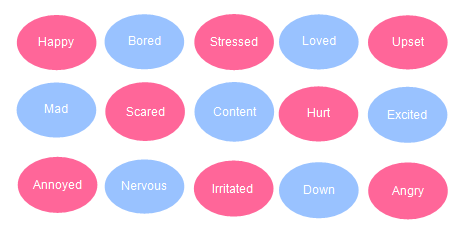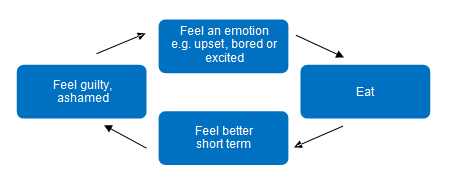Download and print as a PDF (249kB pdf)
On this page
- What is this information about?
- Why have I been given this information?
- What is emotional eating?
- What is the emotional eating cycle?
- How might my emotions become linked to food?
- What is the difference between emotional and physical hunger?
- What clues can help me to tell whether I have emotional or physical hunger?
- How can I map my triggers to my emotional eating?
- What kinds of things could I try that might change my emotional response to a trigger?
- What should I do if I have a setback in managing my emotional eating?
- Which apps, websites and books do you recommend to help me to manage my emotional eating?
- Books
- Who can I contact if I need further information or support after I have read this information?
What is this information about?
This information is about emotional eating. It explains:
- what emotional eating is and how it differs from ‘physical’ hunger
- how you may get into a cycle of emotional eating
- how you can recognise your triggers (causes) for emotional eating
- how you can learn to respond differently to your triggers for emotional eating
- other ways that may help you to avoid emotional eating
- where you can find further advice and support.
Why have I been given this information?
You have been given this leaflet to help you learn why you continue to eat foods you are trying to avoid. The information can help you recognise when you are eating for emotional reasons and how to deal with it.
What is emotional eating?
Emotional eating is when you eat because of a feeling that you have rather than because you need nutrition. Different feelings (emotions) can cause or trigger emotional eating. These can be things that make you feel:
- bad (negative). For example, feeling scared, down, or upset.
- good (positive). For example, feeling happy, loved, or excited.
- neutral (neither good nor bad)

What is the emotional eating cycle?
It is usual for people to use food as a reward or comfort to make them feel better. If you use food in this way to cope with things often or all the time you can get stuck in a cycle. You will eat food that your body does not need.
The emotional eating cycle has these steps:
- You feel an emotion such as upset, bored, or exited.
- Feeling the emotion makes you eat.
- Eating makes you feel better in the short term.
- After a while you feel guilty or ashamed about your emotional eating
- These feelings may cause you further emotional eating.

How might my emotions become linked to food?
We learn to link food with emotions, things that have happened to us and where we are. For example, you might connect:
- a Friday night takeaway with helping you to relax after a stressful week
- birthday cake with making you feel happy
- a hot drink before bed with helping you to sleep
If you repeat these things often, they can become a routine, and you may not even be aware of it.
What is the difference between emotional and physical hunger?
If you often use food to help you deal with your feelings, it can be difficult to tell the difference between emotional and physical hunger. Learning to tell the difference will help you to avoid emotional eating.
One way to do this is to ask yourself “Am I really hungry or do I just want to change the way I feel”.
What clues can help me to tell whether I have emotional or physical hunger?
- Comes on suddenly.
- Feels like it needs to be satisfied instantly.
- Craves specific comfort foods.
- Is not satisfied with a full stomach.
- Comes on gradually.
- Can wait.
- Is open to options. Lots of foods sound good.
- Stops when you’re full.
How can I map my triggers to my emotional eating?
The first step to manage emotional eating is to identify your personal triggers and the thoughts and emotions that link them to your eating. Think about what situations places or thoughts cause you to reach for food.
The following example shows how you can map a trigger to the thought, emotion and emotional eating that follow it.
- Trigger. An argument with your partner which leads to
- Thought. “My relationship is over” which leads to
- Emotion. I am upset and anxious which leads to
- Action. I eat.
Use the space below to write down what you think your triggers are and the thoughts and emotions that lead to emotional eating that are linked to them (please see the PDF of this leaflet).
What kinds of things could I try that might change my emotional response to a trigger?
- Try to reflect on how you respond to your emotions. Plan how you can respond in a different, more positive way in future. There are some examples below:
| Emotion | What does this emotion tell me? | How do I usually respond? | Is this helpful? | How can I respond in future? |
| Boredom | I need something to do. | Have a cup of tea and two biscuits. | No. It stops me from managing my weight and I feel guilty. | Do a crossword. |
| Stress | I am struggling to cope. | Eat chocolate. | No. It stops me from managing my weight and I feel guilty. | Ring a friend. |
| Not able to sleep | I am in pain. | Drink a milky drink. | No. It stops me from managing my weight and I feel guilty. | Speak to your doctor about managing pain and sleep. |
- Build in a pause
Before you eat take time to ask yourself “Am I hungry or do I want to eat because I want to change how I feel?”. This gives you a chance to think about the real reason and decide not to eat.
You may find it scary at first when you stop using food as a comfort to deal with your feelings. You will find that difficult emotions are easier to cope with if you practice building in a pause to ask the question. They may and come less often and be less strong.
- Mindfulness
Use mindfulness to manage emotional eating. Mindfulness is ‘living in the moment’.
Pay full attention to the moment that you are in without judgment. Accept it for what it is. This helps you to consider your thoughts and how they make you behave. This means you will not react to them without realising it by eating food.
Try these or other mindfulness exercises:
- Take ten slow deep breaths to calm your mind and body
- Put your thoughts on a page in a journal or diary (journaling). Many people prefer to write this by hand but you could use an electronic device. Do what seems easier for you.
- ‘Body scan’. This means moving your attention slowly through different parts of your body. Start from the top of your head and move all the way down to the end of your toes.
- Meditate. Use a meditation app or podcast if you find it easier.
- Mindful colouring or drawing. Pay attention to the colours or the feel of the pencil on the page.
- Self care
It is important to look after yourself and find joy and comfort in ways that are not harmful to your health. There are lots of ways in which you can care for yourself that do not involve eating. Make a list of ways that you can care for yourself to give you more options to cope with a trigger.
These might include things such as:
- listening to music
- journaling
- colouring
- crafting
- walking
- spending time with friends, your family or pets.
- playing games.
What self-care ideas do you have? Use the space below to write down ways in which you can care for yourself that do not involve food or eating (please see the PDF of this leaflet).
What should I do if I have a setback in managing my emotional eating?
It is usual to have setbacks when you are making changes. If you have a setback, be kind to yourself. Plan what you will do differently next time you are in that situation.
Which apps, websites and books do you recommend to help me to manage my emotional eating?
- Headspace. Headspace has tools and resources to help you to reduce stress, cope with things better and sleep better.
- Overeaters Anonymous. A community of people who support each other to recover from eating and food behaviours they find hard to control.
- Beat. Beat is the UK’s leading charity for people affected by eating disorders.
Books
- Understanding your eating by Julia Buckroyd
- Emotional first aid kit by Cynthia L. Alexander
- End emotional eating by Jennifer L.Taitz
- You can heal your life by Louise L. Hay
- The little book of mindfulness by Patrizia Collard
Who can I contact if I need further information or support after I have read this information?
Please contact the Bariatric Surgery Service: phone 01243 831 655.
This information is intended for patients receiving care in Brighton & Hove, Chichester (St.Richard’s Hospital), Worthing and Haywards Heath.
The information here is for guidance purposes only and is in no way intended to replace professional clinical advice by a qualified practitioner.